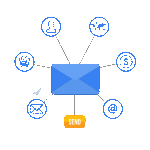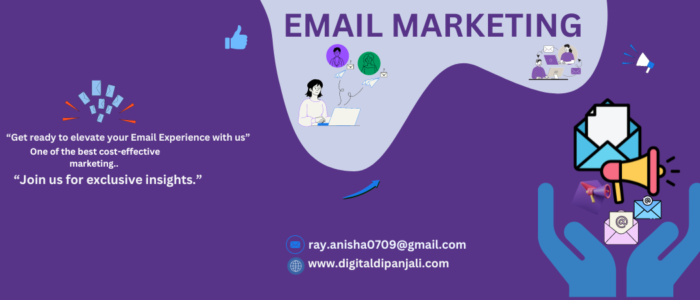EMAIL MARKETING

Email marketing is a powerful digital marketing strategy that involves sending targeted messages to a group of subscribers via email. It allows businesses to engage with their audience, promote products or services, and build lasting relationships with customers. By segmenting their email lists, companies can tailor their messages to specific demographics, ensuring that the content resonates with recipients. Effective email marketing campaigns often include personalized greetings, compelling subject lines, and clear calls to action, driving higher open and click-through rates. Additionally, with the ability to track metrics like open rates and conversions, businesses can continually refine their strategies for better results, making email marketing an essential tool for growth and engagement.
Email marketing is a strategic approach that enables businesses to reach their audience directly through their inboxes. By leveraging customer data, companies can segment their email lists based on various criteria, such as purchase history, location, or engagement level, allowing for highly personalized content. This targeted communication not only improves engagement rates but also fosters customer loyalty, as recipients feel valued and understood.
Email marketing is an essential strategy for businesses looking to cultivate relationships with their customers and boost sales. By effectively segmenting your audience, you can deliver highly relevant content tailored to specific interests and behaviors, ensuring your messages resonate. Crafting compelling subject lines is crucial; a well-worded subject can grab attention and increase open rates. Personalization takes this a step further—incorporating the recipient's name or recommending products based on past purchases can significantly enhance engagement.
Email marketing is a powerful digital marketing strategy that involves sending targeted emails to a group of recipients to promote products, services, or brand awareness. It’s a direct way to communicate with potential and existing customers, fostering relationships and driving engagement.
Key Components of Email Marketing
- Email List Building: A quality email list is foundational. Businesses can grow their lists through sign-up forms on websites, social media, or during checkout processes. Incentives like discounts or exclusive content can encourage sign-ups.
- Segmentation: Dividing your email list into segments based on demographics, behavior, or interests allows for more personalized and relevant content. Tailored messages can lead to higher engagement rates.
- Content Creation: The content of emails should be engaging and valuable. This can include newsletters, promotional offers, product updates, or educational content. Effective subject lines are crucial for improving open rates.
- Automation: Email marketing tools enable automation for sending welcome emails, birthday messages, or follow-ups after purchases. Automation saves time and ensures timely communication with recipients.
- Design and Layout: A visually appealing and mobile-friendly design enhances user experience. Clear calls-to-action (CTAs) should guide readers on the next steps, whether it’s visiting a website or making a purchase.
- Analytics and Tracking: Monitoring key metrics like open rates, click-through rates, and conversion rates helps assess campaign performance. Tools like A/B testing can optimize subject lines and content.
Benefits of Email Marketing
- Direct Communication: Email provides a direct line to customers, allowing for personalized interactions and immediate feedback.
- Cost-Effective: Compared to traditional marketing methods, email marketing is relatively inexpensive, offering high ROI when executed well.
- Measurable Results: With analytics, businesses can track the effectiveness of their campaigns, making it easier to adjust strategies based on performance data.
- Nurturing Leads: Regularly engaging with customers through informative content helps build trust and keeps your brand top-of-mind.
Challenges
- Deliverability Issues: Emails can end up in spam folders or be blocked by email service providers. Maintaining a good sender reputation is crucial.
- Subscriber Fatigue: Sending too many emails can overwhelm subscribers, leading to higher unsubscribe rates. It’s important to find a balance.
- Compliance: Adhering to regulations like GDPR and CAN-SPAM is essential. Marketers must ensure they have permission to email their contacts and provide easy opt-out options.
Best Practices
- Personalization: Use the recipient's name and tailor content to their preferences to create a more personalized experience.
- A/B Testing: Regularly test different elements, like subject lines or send times, to understand what resonates best with your audience.
- Clear CTAs: Ensure that each email has a clear and compelling call-to-action that guides recipients on what to do next.
- Consistent Scheduling: Establish a regular sending schedule to maintain engagement without overwhelming subscribers.
Strategies for Effective Email Marketing
- Welcome Campaigns: When someone subscribes, send a series of welcome emails to introduce your brand, highlight key offerings, and engage new subscribers. This sets a positive tone and helps build a relationship from the start.
- Drip Campaigns: These are automated email sequences sent over time. They can nurture leads by delivering relevant content based on user actions or time since the last interaction. For example, a series of educational emails can be sent after a user downloads a resource.
- Re-engagement Campaigns: For subscribers who haven’t interacted with your emails in a while, consider sending a re-engagement campaign. This can include special offers, surveys, or reminders of what they’re missing.
- Event-Triggered Emails: These emails are sent based on specific actions taken by the subscriber, such as cart abandonment, browsing behavior, or after a purchase. They can effectively encourage conversions by reminding customers of items left in their carts or suggesting related products.
- Seasonal Campaigns: Leverage holidays, seasons, or special events to create themed emails. These campaigns can promote seasonal products or offer time-limited discounts.
Types of Email Campaigns
- Newsletters: Regular updates that share valuable content, industry news, and insights. They help keep your audience engaged and informed.
- Promotional Emails: Focused on sales and discounts, these emails highlight specific products or services and include clear calls to action.
- Transactional Emails: Automated messages that confirm a transaction, such as order confirmations or shipping notifications. While they are primarily functional, they can also include upsell opportunities.
- Surveys and Feedback Requests: Engaging your audience for their opinions can provide valuable insights while making them feel valued.
Tools for Email Marketing
- Email Service Providers (ESPs): Tools like Mailchimp, Constant Contact, and Sendinblue offer features for creating, sending, and analyzing email campaigns. They typically include templates, automation capabilities, and analytics.
- Customer Relationship Management (CRM): Platforms like HubSpot or Salesforce integrate email marketing with customer data, enabling personalized communication based on user behavior.
- Analytics Tools: Platforms like Google Analytics can help track the impact of email campaigns on website traffic and conversions, providing deeper insights into user behavior.
- Design Tools: Tools like Canva can assist in creating visually appealing graphics and layouts for your emails.
Emerging Trends in Email Marketing
- Personalization and AI: Using AI to analyze user behavior allows for hyper-personalization, tailoring content to individual preferences and predicting user needs.
- Interactive Emails: Incorporating elements like polls, quizzes, and carousels can enhance engagement and make emails more dynamic.
- Mobile Optimization: With the increasing use of mobile devices, ensuring emails are responsive and mobile-friendly is crucial for accessibility and user experience.
- Privacy and Compliance: As data privacy becomes more important, marketers must prioritize transparent practices, ensuring compliance with regulations like GDPR and CCPA.
- Integration with Social Media: Cross-channel marketing that integrates email with social media can enhance engagement and broaden reach.
Conclusion
Email marketing is a versatile and effective tool for building customer relationships, driving sales, and enhancing brand loyalty. By employing thoughtful strategies, utilizing the right tools, and keeping up with trends, businesses can create impactful email campaigns that resonate with their audience. As email marketing continues to evolve, staying informed and adaptable will be key to maximizing its potential.
